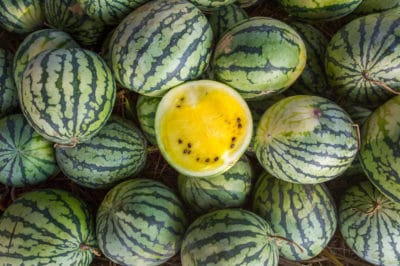Yellow Watermelon Description & Taste
Just like all types of watermelons, yellow watermelons vary widely in size and shape, depending on the particular cultivar, with some types weighing only a couple of pounds, to those weighing over 30 pounds. Shapes vary from round to oblong.
Most types of yellow watermelons resemble their red cousins, and you won’t be able to tell it has yellow-flesh just by looking at the outer skin. The outer skin can be dark to light green and with or without stripes. However, a few yellow flesh cultivars also produce pale yellow skin.
As far as a yellow watermelon’s taste compared to red melons, some people feel they are sweeter with a honey or apricot taste.
Expert Tips: The bottom area where the watermelon touched the ground develops a creamy-yellow coloration when the melon is ripe and ready for picking.
Why the Yellow Color & Are they Nutritious?
Like their red and pink cousins, yellow watermelons contain around 90 percent water, making them thirst quenchers on a hot summer day. Yellow watermelons lack the antioxidant and naturally reddish pigment lycopene, the ingredient that makes tomatoes and watermelons red.
However, yellow watermelons contain small amounts of beta-carotene, commonly associated with the health benefits of carrots.
Nutritional benefits of yellow watermelons include:
- Rich in vitamins A, C, and several from the B group.
- Contains the minerals calcium, phosphorus, magnesium, potassium and iron.
- Fat-free containing around 46 calories per cup.
Watermelon Food Suggestions
For the best taste, chill a whole or sliced yellow watermelon before eating. It tastes great raw, adds a refreshing and cool taste to salads, and it’s low-calorie, juicy sweetness helps satisfy a sweet tooth without guilt.
Watermelon also makes refreshing drinks and pumps up the taste in smoothies. You can also use them for making beverages like margaritas and daiquiris.
Varieties of Yellow Watermelons
Whether you’re looking for a small, icebox size melon, or one that packs on some weight, there’s a yellow watermelon variety that suits your desires.
Listed below are some varieties of yellow watermelons, including those with yellow outer skin, and their characteristics:
- ‘Sunray’ is seedless producing 13-pound, yellow-flesh fruits, with light green skin with stripes. Matures in 85 days.
- ‘Yellow Bird’ is a disease-resistant hybrid producing 12- to 18-pound, yellow-flesh fruits, with striped skin. Matures in 80 to 85 days.
- ‘Butterball Yellow’ is a seedless hybrid producing 12- to 18-pound, oval and yellow-flesh fruits. Matures in 90 to 95 days.
- ‘Yellow Buttercup’ is a hybrid with bright yellow flesh in 14- to 16-pound, oval fruits on short 2- to 3-foot vines. Matures in 90 days.
- ‘Golden Midget’ produces 3-pound fruits, with golden yellow skin and pink inner flesh. Matures in around 70 days.
Expert Tip: Regardless of what you select, yellow watermelons require the same growing conditions as other watermelons. Plant the watermelons once any threat of frost leaves your area and temperatures are consistently warm. Grow in a site that receives full sun for the majority of the day and in fertile, well-drained soil.
